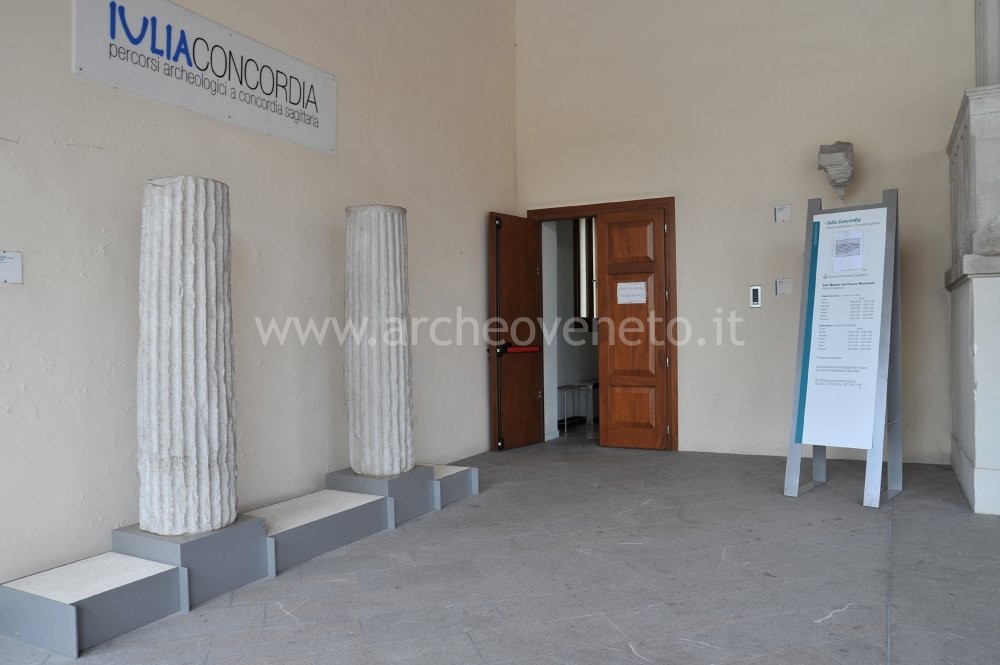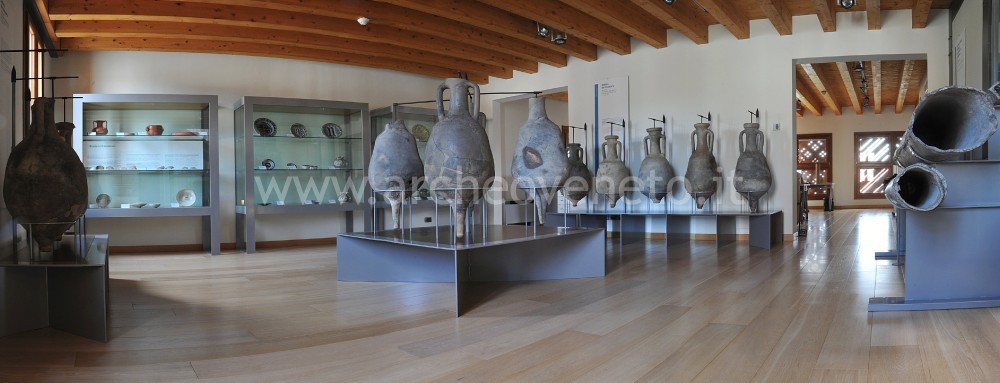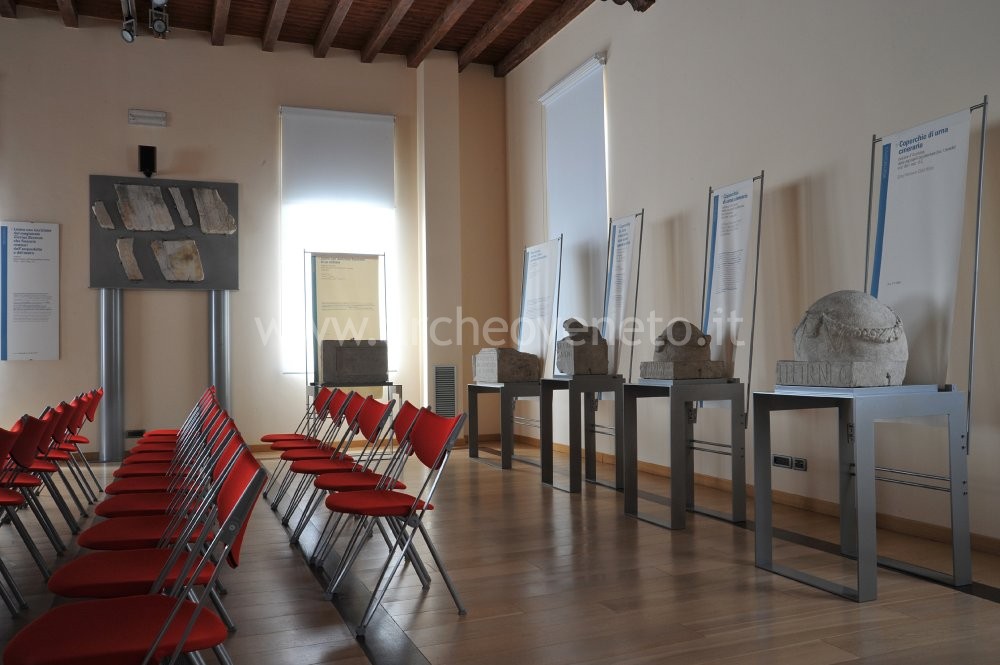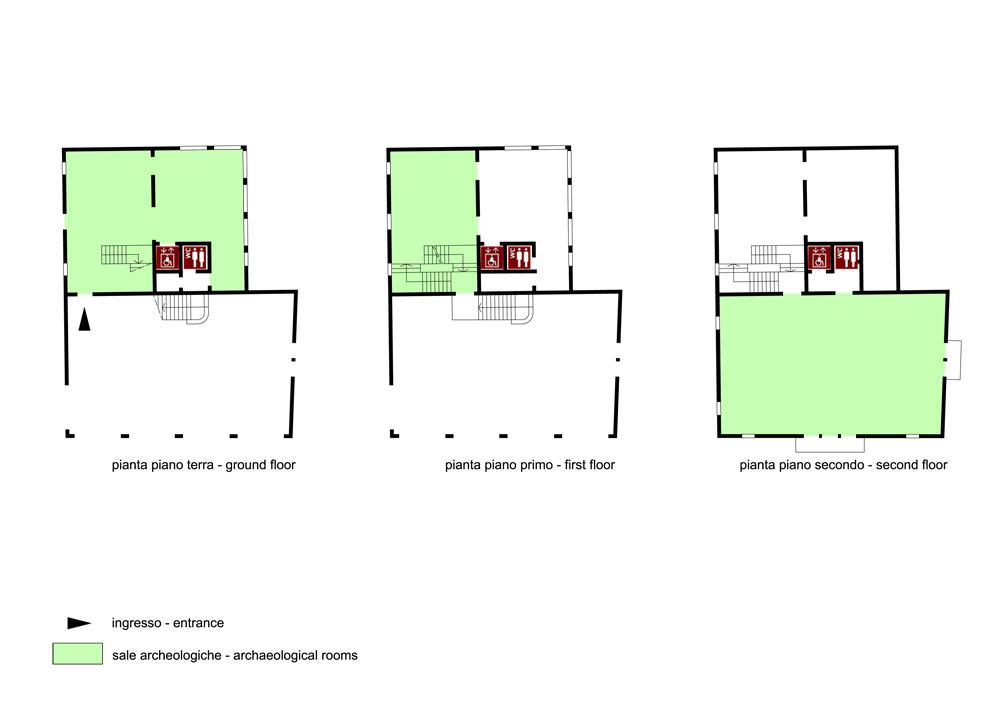|
|
File
Civic Museum – Concordia Sagittaria
|
Via Roma 55 – 30023 Concordia Sagittaria (VE)
– Fax 0421 275364 (Comune) |
  |
|
Summary

The recently refurbished rooms of the Municipal Palace of Concordia Sagittaria contain some finds reporting the history of Iulia Concordia, an ancient roman town. This exhibition serves as natural complement to the rich archaeological heritage that characterizes the modern urban fabric (thermae, domus, theatre, bridge and paleochristian basilica) and is closely linked to the well-known and large National Museum of Concordia in Portogruaro. The virtual visit projected in the room on the ground floor makes several references to the museum in Portogruaro.
Collection history
The museum of Concordia Sagittaria was established in 1987, when the rooms of the Municipal Palace were refurbished. Approximately twenty years later, the permanent exhibition was re-organized adopting modern solutions (touch screens and virtual visits).
|

 As soon as you enter the room on the ground floor you see a large map, showing the main archaeological finds of the colony Iulia Concordia, which enable the visitors to identify the areas in which still today it is possible to see some of the important remains of the roman city. Next to the map there are a bicolour mosaic with geometric patterns discovered in a domus in the south-eastern part of the ancient settlement (1st cent. A.D.), one side of a funeral throne with a dolphin-shaped arm coming from the western necropolis, in the site of Levada (1st cent. A.D.) as well as a pod-shaped ornamental pot from the cemetery of the site of San Giacomo (1st cent. A.D.). As soon as you enter the room on the ground floor you see a large map, showing the main archaeological finds of the colony Iulia Concordia, which enable the visitors to identify the areas in which still today it is possible to see some of the important remains of the roman city. Next to the map there are a bicolour mosaic with geometric patterns discovered in a domus in the south-eastern part of the ancient settlement (1st cent. A.D.), one side of a funeral throne with a dolphin-shaped arm coming from the western necropolis, in the site of Levada (1st cent. A.D.) as well as a pod-shaped ornamental pot from the cemetery of the site of San Giacomo (1st cent. A.D.).
The exhibition goes on with the second section of the room, where you can see a cylindrical urn with its cover and a glass cinerary olla coming from the western necropolis, which also date back to the 1st cent. A.D.
The last part of the room contains the inscriptions of three tombstones, which had different functions: a fragment of a marble milestone with a dedication to the emperor Constantine (312-337 A.D.), a funerary stele from the eastern necropolis (early 1st cent. A.D.) and a sundial found during the excavation of the eastern walls (1st cent. A.D.).
|

 Along the stairs that take to the upper rooms, it is possible to see some wonderful fragments of mosaics with multi-coloured or flower pattern discovered in the area of the ancient thermae of the town and dating back to the 1st-2nd cent A.D. Beside the frescoes there are some maps reconstructing the roman colony Iulia Concordia, which were accomplished in the 19th century by the first discoverers of the ancient traces of the city. Along the stairs that take to the upper rooms, it is possible to see some wonderful fragments of mosaics with multi-coloured or flower pattern discovered in the area of the ancient thermae of the town and dating back to the 1st-2nd cent A.D. Beside the frescoes there are some maps reconstructing the roman colony Iulia Concordia, which were accomplished in the 19th century by the first discoverers of the ancient traces of the city.
|

 The second room contains a dozen of transport amphoras (1st -2nd cent. A.D.) found in the square in front of the basilica and in different parts of the city as well as numerous examples of lead fistulae (water pipes) stamped with the names of the producers, coming from different areas of the ancient settlement. Beside them, there are three display cases containing ceramic fragments of different ages (from the 1st to the 8th cent.); in particular the first display case contains examples of Italian sigillata from northern Italy (late 1st cent. B.C.-1st cent. A.D.) and of African sigillata (3rd – 5th cent. A.D.), as well as amphora stamps (1st-2nd cent. A.D.). The second room contains a dozen of transport amphoras (1st -2nd cent. A.D.) found in the square in front of the basilica and in different parts of the city as well as numerous examples of lead fistulae (water pipes) stamped with the names of the producers, coming from different areas of the ancient settlement. Beside them, there are three display cases containing ceramic fragments of different ages (from the 1st to the 8th cent.); in particular the first display case contains examples of Italian sigillata from northern Italy (late 1st cent. B.C.-1st cent. A.D.) and of African sigillata (3rd – 5th cent. A.D.), as well as amphora stamps (1st-2nd cent. A.D.).
|

 At the bottom of the large council room there are four inscribed plates, the covers of three funerary urns and an undamaged urn. The first three inscriptions are funerary inscriptions coming from the western and the eastern necropolises, whereas the fourth one, which is in marble, celebrates an important magistrate of the town that commissioned the refurbishment of the aqueduct and the theatre between the end of the 1st cent. and the beginning of the 2nd cent. A.D. At the bottom of the large council room there are four inscribed plates, the covers of three funerary urns and an undamaged urn. The first three inscriptions are funerary inscriptions coming from the western and the eastern necropolises, whereas the fourth one, which is in marble, celebrates an important magistrate of the town that commissioned the refurbishment of the aqueduct and the theatre between the end of the 1st cent. and the beginning of the 2nd cent. A.D.
There are also two urn covers in limestone from Aurisina decorated with festoons and bucrania (early 1st cent. A.D.) coming from the western necropolis (site of Levada), as well as an urn cover with an apotropaic lion (early 1st cent. A.D.) and a freedman’s relief decorated urn with some dogs guarding the burial (1st cent. A.D.) found in the eastern necropolis (site of San Giacomo).
|

Admission: Negli orari di apertura
Ticket: No
 School access School access
 Disabled access Disabled access
Opening Days
| Tipology |
When |
Specs |
| Summer |
Tuesday |
10.30 – 12.30 e 14.30 – 18.30 |
| Summer |
Wednesday |
10.30 – 12.30 e 14.30 – 18.30 |
| Summer |
Thursday |
10.30 – 12.30 e 14.30 – 18.30 |
| Summer |
Friday |
10.30 – 12.30 e 14.30 – 18.30 |
| Summer |
Saturday |
10.30 – 12.30 e 14.30 – 18.30 |
| Summer |
Sunday |
10.30 – 12.30 e 14.30 – 18.30 |
| Winter |
Tuesday |
10.30 – 12.30 e 14.30 – 17.30 |
| Winter |
Wednesday |
10.30 – 12.30 e 14.30 – 17.30 |
| Winter |
Thursday |
10.30 – 12.30 e 14.30 – 17.30 |
| Winter |
Friday |
10.30 – 12.30 e 14.30 – 17.30 |
| Winter |
Saturday |
10.30 – 12.30 e 14.30 – 17.30 |
| Winter |
Sunday
|
10.30 – 12.30 e 14.30 – 17.30 |
Opening hours very changeable. Please call.
Recommended tour time (minutes): 20
 Toilet Toilet
 Brochure Brochure
Guide a stampa
Italian
 Information boards Information boards
Italian
 Captions under exhibits Captions under exhibits
Italian
 PC learning points PC learning points
 Guided Tours Guided Tours
 Educational activities Educational activities
 Educational workshops Educational workshops
In the rooms of the former municipal library (Circolo Antiqui).
 Library and documentation centre Library and documentation centre
In the rooms of the former municipal library (Circolo Antiqui).
 Other activities Other activities
Council room.
| Il Museo Civico di Concordia Sagittaria 1987, Concordia Sagittaria. |
| Pettenò E., Dal Pos M., De Paoli M. 2007, Forma Urbis. Percorsi archeologici a Iulia Concordia. Parte prima, in Quaderni di Archeologia del Veneto, XXIII, pp. 204-211. |
| Bonetto J. 2009, Veneto (Archeologia delle Regioni d’Italia), Roma, pp. 437-438. |
|

